When it comes to childhood viral infections, measles and chickenpox are two distinct conditions that can sometimes be confused due to their similar presentation of rashes. Understanding the differences between these infectious diseases is crucial for proper identification, treatment, and prevention.
Both conditions are highly contagious but have unique characteristics that set them apart. Let's explore their key differences, symptoms, and treatment approaches to help you better understand these common viral infections.
Understanding the Basics of Both Conditions
Measles is caused by the rubeola virus and is considered one of the most contagious infectious diseases. Chickenpox, on the other hand, is caused by the varicella-zoster virus (VZV) and is also highly infectious but generally less severe in most healthy children.
Distinctive Rash Characteristics
Measles Rash
The measles rash typically appears 3-5 days after initial symptoms begin. It has several distinctive features:
- Starts on the face and behind the ears
- Spreads downward to the chest, back, and extremities
- Flat, red spots that may join together
- Appears in a head-to-toe pattern
- Usually lasts 5-6 days
Chickenpox Rash
The chickenpox rash has very different characteristics:
- Begins on the chest, back, and face
- Spreads randomly across the body
- Appears as itchy, fluid-filled blisters
- Different stages of spots present simultaneously
- New spots continue to form for several days
Early Symptoms and Progression
Measles Initial Signs
Measles typically begins with:
- High fever
- Severe cough
- Runny nose
- Red, watery eyes
- Koplik's spots (white spots inside mouth)
- Symptoms appear 10-14 days after exposure
Chickenpox Initial Signs
Chickenpox usually starts with:
- Mild fever
- Headache
- Loss of appetite
- Fatigue
- Symptoms appear 14-16 days after exposure
Prevention and Vaccination
Both diseases can be prevented through vaccination. The MMR vaccine provides protection against measles, while the varicella vaccine prevents chickenpox. These vaccines are part of the recommended childhood immunization schedule and have significantly reduced the incidence of both diseases.
Treatment Approaches
Treatment strategies differ for each condition:
- Measles requires close monitoring and supportive care
- Chickenpox treatment focuses on symptom relief
- Both conditions may require specific medications based on severity and complications
- Rest and proper hydration are essential for both
Frequently Asked Questions
What are the key differences in symptoms between measles and chickenpox?
The main differences lie in their initial symptoms and rash patterns. Measles typically causes more severe symptoms including high fever, severe cough, and red eyes, with a flat red rash that spreads from head to toe. Chickenpox usually begins with mild fever and fatigue, followed by itchy, fluid-filled blisters that appear in crops across the body.
How can I tell the difference between the rashes caused by measles and chickenpox?
Measles rash appears as flat, red spots that may join together and spreads in a head-to-toe pattern. Chickenpox rash consists of itchy, fluid-filled blisters that appear in different stages simultaneously and spread randomly across the body.
What are the common complications of measles compared to chickenpox?
Measles can lead to serious complications including pneumonia, encephalitis, and ear infections. Chickenpox complications are typically less severe but can include skin infections, scarring, and rarely, pneumonia or brain inflammation, especially in adults or immunocompromised individuals.
How are measles and chickenpox transmitted and how can they be prevented?
Both diseases spread through respiratory droplets and direct contact. Prevention primarily involves vaccination - MMR vaccine for measles and varicella vaccine for chickenpox. Good hygiene practices and avoiding contact with infected individuals also help prevent transmission.
What treatment options are available for measles versus chickenpox?
Both conditions primarily require supportive care. For measles, treatment focuses on managing symptoms and preventing complications. Chickenpox treatment typically involves anti-itch medications, calamine lotion, and fever reducers. Antiviral medications may be prescribed in severe cases or for high-risk patients.




